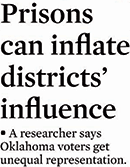Fixing prison-based gerrymandering after the 2010 Census: Oklahoma
50 State Guide, March 2010
Prison-based gerrymandering violates the constitutional principle of "One Person, One Vote." The Supreme Court requires districts to be based on equal population in order to give each resident the same access to government. But a longstanding flaw in the Census counts incarcerated people as residents of the prison location, even though they can’t vote and aren’t a part of the surrounding community.
When legislators claim people incarcerated in their districts are legitimate constituents, they award people who live close to the prison more of a say in government than everybody else.
Impact at the state level:
- Without using prison populations as padding, 7 Oklahoma House districts drawn after the 2000 Census did not meet constitutional population requirements.
- For example, each House district in Oklahoma should have 34,165 residents. District 22 (Murray, Garvin, Pontotoc, McClain and Cleveland counties), however, has only 31,530 actual residents. This gives every 93 residents of District 22 as much say over state affairs as 100 people elsewhere in the state.
- Crediting all of Oklahoma’s incarcerated people to a few locations, far from home, enhances the political clout of the people who live near prisons, while diluting voting power of all other Oklahomans.
Impact at the local level:
- In Alfalfa County, District 3, drawn after the 2000 Census, derived 46% of its population from the James Crabtree Correctional Center; effectively giving every 54 residents of District 3 the same political clout as 100 residents elsewhere in the county.
- Prison-based gerrymandering after the 2000 Census has also been identified in the following counties: Atoka, Beckham, Blaine, Caddo, Canadian, Comanche, Craig, Hughes, Jefferson, Muskogee, Okfuskee, Osage, Pittsburg, Woods, and Woodward.
- Greer County removed the prison population before redistricting after the 2000 Census, thereby avoiding using the prison population to dilute the votes of county residents who do not live near the prison.
- New and expanded prisons in Comanche and Woodward counties will make the importance of avoiding prison-based gerrymandering even larger after the 2010 Census than it was a decade ago, and a new prison in Pottawatomie County will require the county to address prison-based gerrymandering for the first time after the 2010 Census.
- The City of McAlester avoided prison-based gerrymandering by excluding prison populations from their data when redistricting the City Council after the 2000 Census.
- The cities of Cushing, El Reno, Lawton, Sayre, Vinita, Watonga, Waurika all risk distorting their City Council districts with prison populations unless they follow McAlester's example and adjust the redistricting data.
Other solutions:
- All Oklahoma municipalities that contain prisons should adopt similar solutions to Greer County, which already bases its districts on actual, not prison populations.
- Ideally, the U.S. Census Bureau would change where it counts incarcerated people. They should be counted as residents of their home — not prison — addresses. There is no time for that in 2010, but Oklahoma should ask the Census Bureau for this change for 2020.
Additional resources:
- Importing Constituents: Prisoners and Political Clout in Oklahoma, is a district-by-district analysis of prison-based gerrymandering in Oklahoma state legislative and county districts.
-
 Prisons can inflate districts' influence: A researcher says Oklahoma voters get unequal representation, by Michael Overall, Tulsa World (Tulsa, Okla.) September 20, 2009
Prisons can inflate districts' influence: A researcher says Oklahoma voters get unequal representation, by Michael Overall, Tulsa World (Tulsa, Okla.) September 20, 2009 - Prison-Based Gerrymandering in Oklahoma Counties [PDF] Prison Policy Initiative. May, 2010.
- A list of new large prisons built in Oklahoma since the 2000 Census. These prisons are likely to create new prison-based gerrymandering problems after their populations are counted in the 2010 census.
Events
- April 15-17, 2025:
Sarah Staudt, our Director of Policy and Advocacy, will be attending the MacArthur Safety and Justice Challenge Network Meeting from April 15-17 in Chicago. Drop her a line if you’d like to meet up!
Not near you?
Invite us to your city, college or organization.
 Prisons can inflate districts' influence: A researcher says Oklahoma voters get unequal representation, by Michael Overall, Tulsa World (Tulsa, Okla.) September 20, 2009
Prisons can inflate districts' influence: A researcher says Oklahoma voters get unequal representation, by Michael Overall, Tulsa World (Tulsa, Okla.) September 20, 2009


